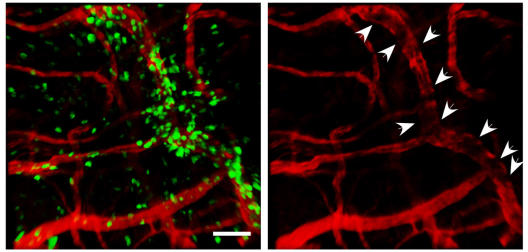Prof. Dr. Lydia Sorokin
Mechanisms of Leukocyte Transmigration Across Basement Membranes

Immunology
Vascular Biology / Angiogenesis
Immune cell trafficking
Cell-matrix interactions
Work in our lab focuses on mechanisms of leukocyte transmigration of the endothelial barrier during inflammation, with focus on basement membranes and the extracellular matrix. Our aim is to distinguish between molecular and mechanical information imparted by the endothelial basement membrane on extravasating leukocytes. All endothelial BMs are composed of collagen IV, heparan sulfate proteoglycans, nidogens and laminins 411 and 511 (composed of laminin alpha4beta1gamma1 chains and alpha5beta1gamma1 chains, respectively). At the level of postcapillary venules, where extravasation exclusively occurs, there is ubiquitous express of laminin 411 and a patchy distribution of laminin 511. Extravasation of all leukocyte types occurs only at sites of little or no laminin 511. In vitro studies have shown that laminin 511 is a highly adhesive substrate and that it blocks the migration of most leukocyte types, with most pronounced effects on T cells compared to neutrophils and monocytes. This project will decipher between the effects of molecular signalling imparted by laminins 511 and 411 on immune cell penetration of BMs, versus biophysical aspects of BMs and of the immune cells themselves. The studies will involved a combination of in vivo experiments using mice lacking specific BM components in different inflammatory models and live imaging of immune cells, as well as in vitro adhesion and migration assays. In vitro experiments will investigate leukocyte migration across excised BMs or in artificial 2D and 3D substrates, including microchannels, which mimic the mechanical constraints of the in vivo environment. The project requires collaboration between cell biologists/immunologists, biophysicists and mathematicians.

Vita
- 1977-1981: BSc (Hons): Undergraduate studies in Biochemistry, Physiology, Zoology, University of Western Australia, Perth, Western Australia.
- 1984-1987: PhD, University of Western Australia, Perth, Western Australia.
- 1988-1990: DAAD postdoctoral stipendium for work with Prof. Dr. P. Ekblom, Friedrich-Miescher-Laboratory of the Max-Planck Society, Tübingen, Germany.
- 1991-1993: Postdoc with Prof. Dr. K. von der Mark, Max-Planck Society, Connective Tissue Research Group, Erlangen, Germany.
- 1994-1999: Group Leader, Institute for Experimental Medicine, University of Erlangen-Nürnberg, Erlangen, Germany.
- 1999: Habilitation, Cell and Developmental Biology, University of Erlangen-Nürnberg, Erlangen, Germany
- 1999-2001: Junior Professor (Nachwuchsgruppenleiterin), Interdisciplinary Center for Clinical Research, Nikolaus Fiebiger Center, University of Erlangen-Nürnberg, Germany.
- Since 2001: Adjunct Professorship in Anatomy and Human Biology at the University of Western Australia, Perth, Australia
- 2001: Awarded Swedish Natural Science Research Council Senior Research Fellowship.
- 2001-2004: Chair of Tissue Biology, Head of Experimental Pathology, University of Lund, Sweden.
- Since 2005: Chair of Pathobiochemisty, University of Münster, Germany
- Since 2012: Spokesperson of the Cells-in-Motion Cluster of Excellence
Selected references
Di Russo J, Luik A-L, Yousif L, Oberleithner H, Hofschröer V, Klingauf J, van Bavel E, Bakker E N T P, Hellstrand P, Bhattachariya A, Albinsson S, Pincet F, Hallmann R, Sorokin L (2017). Endothelial basement membrane laminin 511 is essential for shear stress response. EMBO J. 36: 183-201
Gerwien H, Hermann S, Zhang X, Korpos E, Song J, Kopka K, Faust A, Wenning C, Gross CC, Honold L, Melzer N, Opdenakker G, Wiendl H, Schäfers M, Sorokin L (2016). Imaging matrix metalloproteinase activity in multiple sclerosis as a specific marker of leukocyte penetration of the blood-brain barrier. Sci Transl Med. 8: 364ra152.
Wu, C, Ivars, F., Andersson, P., Hallmann, R., Vestweber, D., Nilsson, P., Robenek, H., Tryggvason, K., Loser, K., Beissert, S. and Sorokin, L. (2009). Endothelial basement membrane laminin alpha5 selectively Inhibits T lymphocyte extravasation into the brain. Nature Medicine 15, 519-527
Agrawal, S., Anderson, P., Durbeej, M., van Rooijen, N., Ivars, F., Opdenakker, G., and Sorokin, L. M. (2006). Dystroglycan is selectively cleaved at the parenchymal basement membrane at sites of leukocyte extravasation in experimental autoimmune encephalomyelitis. J Exp Med 203, 1007-1019
Sixt, M., Kanazawa, N., Selg, M., Samson, T., Roos, G., Reinhardt, D. P., Papst, R., Lutz, M. B. and Sorokin, L. (2005). The conduit system transports soluble antigens from the afferent lymph to resident dendritic cells in the T cell area of the lymph node. Immunity 22, 19-30.
Links
